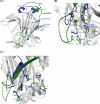Calcium binds to LipL32, a lipoprotein from pathogenic Leptospira, and modulates fibronectin binding
- PMID: 19948735
- PMCID: PMC2823465
- DOI: 10.1074/jbc.M109.006320
Calcium binds to LipL32, a lipoprotein from pathogenic Leptospira, and modulates fibronectin binding
Abstract
Tubulointerstitial nephritis is a cardinal renal manifestation of leptospirosis. LipL32, a major lipoprotein and a virulence factor, locates on the outer membrane of the pathogen Leptospira. It evades immune response by recognizing and adhering to extracellular matrix components of the host cell. The crystal structure of Ca(2+)-bound LipL32 was determined at 2.3 A resolution. LipL32 has a novel polyD sequence of seven aspartates that forms a continuous acidic surface patch for Ca(2+) binding. A significant conformational change was observed for the Ca(2+)-bound form of LipL32. Calcium binding to LipL32 was determined by isothermal titration calorimetry. The binding of fibronectin to LipL32 was observed by Stains-all CD and enzyme-linked immunosorbent assay experiments. The interaction between LipL32 and fibronectin might be associated with Ca(2+) binding. Based on the crystal structure of Ca(2+)-bound LipL32 and the Stains-all results, fibronectin probably binds near the polyD region on LipL32. Ca(2+) binding to LipL32 might be important for Leptospira to interact with the extracellular matrix of the host cell.
Figures




Similar articles
-
Calcium binding to leptospira outer membrane antigen LipL32 is not necessary for its interaction with plasma fibronectin, collagen type IV, and plasminogen.J Biol Chem. 2012 Feb 10;287(7):4826-34. doi: 10.1074/jbc.M111.277210. Epub 2011 Dec 6. J Biol Chem. 2012. PMID: 22147698 Free PMC article.
-
Structure and calcium-binding activity of LipL32, the major surface antigen of pathogenic Leptospira sp.J Mol Biol. 2009 Jul 24;390(4):722-36. doi: 10.1016/j.jmb.2009.05.034. Epub 2009 May 25. J Mol Biol. 2009. PMID: 19477185
-
The lipoprotein LipL32, an enigma of leptospiral biology.Vet Microbiol. 2013 Mar 23;162(2-4):305-314. doi: 10.1016/j.vetmic.2012.11.005. Epub 2012 Nov 9. Vet Microbiol. 2013. PMID: 23206414 Review.
-
Calcium binds to leptospiral immunoglobulin-like protein, LigB, and modulates fibronectin binding.J Biol Chem. 2008 Sep 12;283(37):25140-25149. doi: 10.1074/jbc.M801350200. Epub 2008 Jul 14. J Biol Chem. 2008. PMID: 18625711
-
Insight into the Structure, Functions, and Dynamics of the Leptospira Outer Membrane Proteins with the Pathogenicity.Membranes (Basel). 2022 Mar 7;12(3):300. doi: 10.3390/membranes12030300. Membranes (Basel). 2022. PMID: 35323775 Free PMC article. Review.
Cited by
-
Leptospiral Infection, Pathogenesis and Its Diagnosis-A Review.Pathogens. 2021 Feb 1;10(2):145. doi: 10.3390/pathogens10020145. Pathogens. 2021. PMID: 33535649 Free PMC article. Review.
-
Leptospira: a spirochaete with a hybrid outer membrane.Mol Microbiol. 2010 Aug;77(4):805-14. doi: 10.1111/j.1365-2958.2010.07262.x. Epub 2010 Jun 28. Mol Microbiol. 2010. PMID: 20598085 Free PMC article. Review.
-
Elastin, a novel extracellular matrix protein adhering to mycobacterial antigen 85 complex.J Biol Chem. 2013 Feb 8;288(6):3886-96. doi: 10.1074/jbc.M112.415679. Epub 2012 Dec 17. J Biol Chem. 2013. PMID: 23250738 Free PMC article.
-
Leptospira as an emerging pathogen: a review of its biology, pathogenesis and host immune responses.Future Microbiol. 2010 Sep;5(9):1413-25. doi: 10.2217/fmb.10.102. Future Microbiol. 2010. PMID: 20860485 Free PMC article. Review.
-
Novel mycobacteria antigen 85 complex binding motif on fibronectin.J Biol Chem. 2012 Jan 13;287(3):1892-902. doi: 10.1074/jbc.M111.298687. Epub 2011 Nov 29. J Biol Chem. 2012. PMID: 22128161 Free PMC article.
References
-
- Farr R. W. (1995) Clin. Infect. Dis. 21, 1–6 - PubMed
-
- Biegel E., Mortensen H. (1995) Ugeskr. Laeger 157, 153–157 - PubMed
-
- Bharti A. R., Nally J. E., Ricaldi J. N., Matthias M. A., Diaz M. M., Lovett M. A., Levett P. N., Gilman R. H., Willig M. R., Gotuzzo E., Vinetz J. M. (2003) Lancet 3, 757–771 - PubMed
-
- Yang C. W. (2007) Kidney Int. 72, 918–925 - PubMed
-
- Dolhnikoff M., Mauad T., Bethlem E. P., Carvalho C. R. (2007) Braz. J. Infect. Dis. 11, 142–148 - PubMed
Publication types
MeSH terms
Substances
Associated data
- Actions
LinkOut - more resources
Full Text Sources
Miscellaneous

